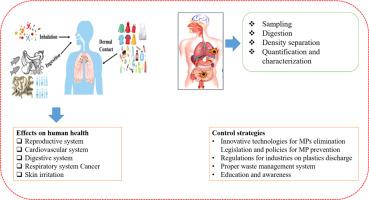Human exposure to microplastics: A review on exposure routes and public health impacts
IF 5.4
Q2 ENGINEERING, ENVIRONMENTAL
引用次数: 0
Abstract
The presence of microplastics (MPs) in human body parts has raised significant concerns due to their status as a major environmental pollutant. Despite existing methods for detecting and identifying MPs in human tissues, there is a lack of standardized techniques, compromising the comparability of data across studies. This review critically analyzes the current knowledge on MPs in human body parts, sources and potential exposure pathways. This study underscores the urgent need for standardized and validated techniques for accurate MP analysis and characterization in human tissues, addressing the methodological challenges in MP detection. The findings of this review indicate that humans are exposed to MPs potentially through several routes such as ingestion, inhalation and dermal contact. However, the exact routes for MPs entering the body remain unclear. It also examines the wide range of health impacts associated with MPs, such as oxidative stress, inflammatory responses, endocrine disruption, and potential genotoxicity. Nevertheless, the cellular and molecular mechanisms underlying these effects are still not well understood, especially when considering the diverse concentrations, shapes, and sizes of MPs. Therefore, further research is essential, particularly to enhance epidemiological studies that can robustly establish the link between MP exposure and health impacts in large populations. Advancing this knowledge will be crucial for developing effective strategies to safeguard both environmental and public health from the detrimental effects of MPs.

人类与微塑料的接触:关于接触途径和公共健康影响的综述
微塑料(MPs)是一种主要的环境污染物,其在人体组织中的存在已引起人们的极大关注。尽管现有方法可以检测和识别人体组织中的微塑料,但由于缺乏标准化技术,影响了不同研究数据的可比性。本综述批判性地分析了有关人体部位、来源和潜在暴露途径中 MPs 的现有知识。这项研究强调,迫切需要标准化和经过验证的技术来准确分析和描述人体组织中的多溴联苯醚,从而解决多溴联苯醚检测方法上的难题。本综述的研究结果表明,人类可能会通过摄入、吸入和皮肤接触等几种途径接触到 MPs。不过,MPs 进入人体的确切途径仍不清楚。研究还探讨了 MPs 对健康的广泛影响,如氧化应激、炎症反应、内分泌紊乱和潜在的遗传毒性。然而,人们对这些影响的细胞和分子机制仍不甚了解,特别是考虑到多孔质微粒的浓度、形状和大小各不相同。因此,进一步的研究至关重要,尤其是要加强流行病学研究,以便在大量人群中有力地确定 MP 暴露与健康影响之间的联系。增进这方面的知识对于制定有效的策略以保护环境和公众健康免受多孔介质的有害影响至关重要。
本文章由计算机程序翻译,如有差异,请以英文原文为准。
求助全文
约1分钟内获得全文
求助全文
来源期刊

Journal of hazardous materials advances
Environmental Engineering
CiteScore
4.80
自引率
0.00%
发文量
0
审稿时长
50 days
 求助内容:
求助内容: 应助结果提醒方式:
应助结果提醒方式:


